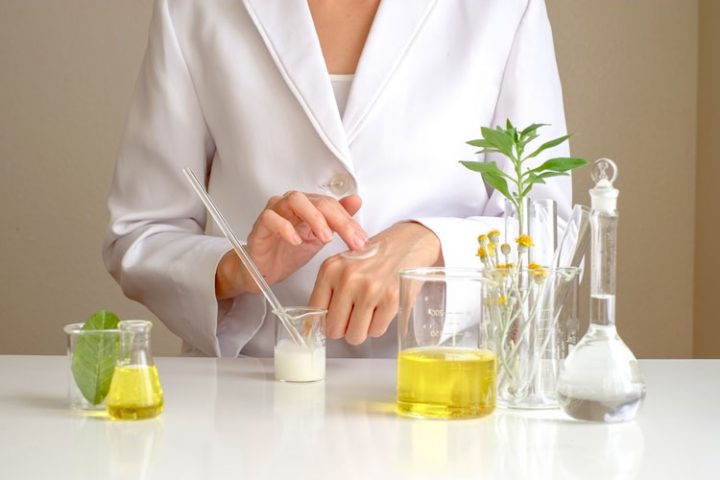
As a scientist I am aware of the power of laboratory created ingredients and the positive impact they can have on skin. There are also many natural product ranges on the market that are extremely nurturing but may not create the same level of biological impact.
The secret to formulating in my opinion is to harness the very best of laboratory science with naturally derived ingredients in synergy to create the most effective products that create perceivable changed, penetrate the skin for optimal delivery and are cosmetically elegant to use for the consumer.
This is why I have trademarked the Synergie ‘clean science®’ philosophy. As a formulator, it is often as important what I don’t include in the product as what I do include. I have my own list of what I refer to as ‘questionable ingredients’. These are chemical additives that I believe can be harmful to cells when allowed to accumulate over time. A compelling scientific study showed that women absorb over 3 kilograms of chemicals from cosmetics and toiletries annually.
As a brief overview, I advise customers to avoid the following ingredients on their cosmetic products:
- Paraben preservatives
- Artificial colour (FD&C dyes)
- Artificial fragrance
- Phthalates
- SLS and other foaming sulfates
- PEG
- Propylene glycol
- Isopropyl alcohol
Unfortunately, the term ‘natural’ and organic’ is used too loosely in the cosmetic industry. Natural is not always best and it is important to understand the concept of ‘natural’ in our industry and realise that natural ingredients can be extremely harmful. Arsenic, for example, is 100% natural but less than 1/8th of a teaspoon can be fatal. The beautiful oleander shrub can be organically grown but may result in cardiac arrest is the leaves or flowers are ingested!
Many laboratory made ingredients used in skin care products are a bio-identical copy to the natural form. However, the laboratory synthesised form can be 100% pure and free of contaminants or pesticides as it is manufactured under sterile conditions. A good example of this is the ingredient Phycosaccharide which is an active ingredient that promotes skin repair and reduced inflammation. This complex sugar is copied in the laboratory to avoid depleting the coast of seaweed reserves where this ingredient exists in nature. In this case, the synthetic ingredient is effective, nature identical, pure and environmentally sustainable.
Decisions based on natural versus synthetic are personal. As a clean science formulator look at the two factors:
- The overall safety profile of the ingredient. Both natural (arsenic) and synthetic (parabens, PEG, artificial colour) ingredients can be questionable and even toxic. Thoroughly read scientific evidence based on the individual ingredient.
- The benefit and effectiveness of the ingredient. If a particular ingredient is a laboratory made synthetic (e.g. peptides to minimise the appearance of wrinkles) and does not present as a questionable or potentially toxic ingredient, then it is, in my opinion, a perfectly valid addition to a product. Natural is not always best. Clean Science formulating uses the very best of both science and nature in synergy. Harnessing the positive attributes from both will result in a product that produces the best results with the highest safety profile.
To watch me chat through Clean Science and my philosophy as a formulator further, click here.
Not sure what products are suitable for your skin type? Head to our Analyse Your Skin quiz to find your routine – your skin confidence begins here.
